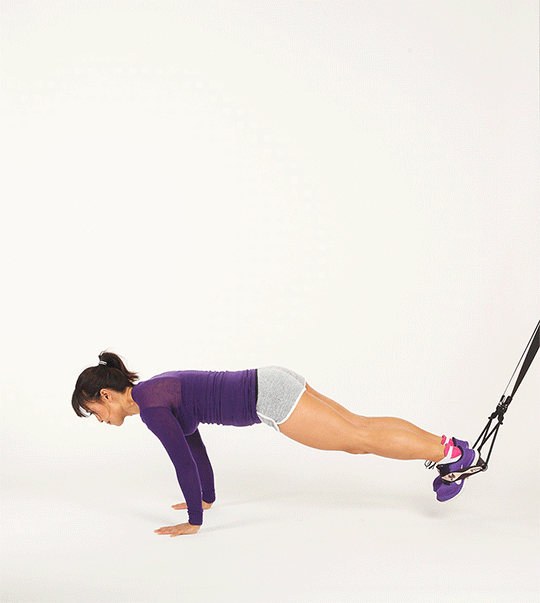The Top 4 TRX Workouts For Beginners
For a full-body workout that improves your strength and endurance, look to resistance training.
Exercises like squat thrusts, pull ups, and the bench press help to enhance everyday performance and develop your mobility, flexibility, and balance.
But what’s the deal with a resistance TRX workout?
TRX workouts use your body weight as resistance and offer plenty of variety within your routine for both upper body and lower body strength. Plus, in scientific studies, they have been shown to increase arm strength,1 improve the performance of handball players,2 and offer myriad benefits for older (60+) participants.3
In this guide, we’ll take a closer look at TRX and how you can incorporate it into your workout routine as a beginner.
What is TRX?
TRX training—which stands for Total Body Resistance Exercise—originated as a bodyweight workout for the Navy SEALS. Rather than using traditional resistance training tools like weights, cables, resistance bands, or machines, a TRX exercise only requires one prop—a suspension trainer.
When attached to the ceiling, this portable rope leverages gravity and your body weight to help you build strength. Simply hold on to the handlebars on each side and begin your workout. Whether you are someone who prefers a morning or evening workout, TRX training can be incorporated anytime and offers a new and unique way to get a rock-solid workout that targets the whole body.
For those new to TRX training, let’s look at four exercises to get you started.4,5
#1 Low Rows
This TRX exercise targets your back muscles. It’s also an effective workout for beginners because the movement feels intuitive, almost like a reverse push-up. To perform a TRX low row, follow these steps:
- Step 1 – Anchor your TRX ropes to a point above your head. Facing the anchor point, grab the handles.
- Step 2 – Engage your core and glutes to make your body rigid like a plank.
- Step 3 – Pull yourself toward the anchor point by using the muscles in your back and contracting your arms.
- Step 4 – Slowly lower yourself back down, resisting the urge to fall under gravity to perform slow and controlled movements.
- Step 4 – Repeat the reps as you feel comfortable.
To increase the difficulty of the low row, simply walk forward to place more of your body weight under the force of gravity. To decrease the difficulty, walk back to move diagonally.
#2 Chest Press
Once you’ve mastered the low row, you should have no problem figuring out the chest press and adding it to your TRX workout as it’s a very similar movement. This will work the same way as a pushup, but you can adjust the level of difficulty by walking forward (less difficult) or backward (more difficult).
Here’s how to perform one rep of a TRX chest press:
- Step 1 – Use the same setup as the low row, but this time face away from the anchor when you grip the handles. The ends of the suspension ropes should now be at your sides.
- Step 2 – Slowly lower yourself by bending at the elbows, resisting the urge to fall under the force of gravity. Keep your shoulders retracted (pulled back) to make sure that your chest is the main muscle working.
- Step 3 – Push from your chest, extending your arms to press your bodyweight back up. Be sure to engage your core and glutes for the best results.
#3 Plank
A plank is an effective way to strengthen your core and stabilize your everyday movements. And incorporating suspension ropes into your plank workout can make it all the more challenging and prepare you for more advanced TRX workouts since your legs will be suspended in the air.
Here’s how to plank with suspension ropes:
- Step 1 – With a high anchor point, place your feet in the handles. Be sure the ropes are still forward of the anchor or it can start to feel like they are pulling you backward during the exercise.
- Step 2 – Get into a push-up position with your hands on the floor and your arms extended. Your suspended feet will be behind you, positioning your body into a straight line. To reduce the difficulty level, you can place your elbows on the floor rather than your hands.
- Step 3 – Hold this plank position while engaging your core and squeezing your glutes. Hold as long as one minute, then relax. Repeat as desired.
#4 Squat
A TRX squat can improve strength in your glutes, calves, quadriceps, and hamstrings as well as increase flexibility within your hip flexors. Performing a squat using a suspension trainer may also help to maintain proper form and improve your stability as you lower yourself up and down—just follow these simple steps:
- Step 1 – Grab the handles while standing a few steps back from the anchor point. Be sure there is tension in the ropes.
- Step 2 – Holding the handles, squat down with your feet about shoulder length apart. They should point slightly out in a way that maximizes your hip flexibility.
- Step 3 – As you squat, use the tension of the ropes to ensure that your upper body doesn’t collapse and that your lower back doesn’t shift forward.
- Step 4 – Stand back up using the ropes to provide support and maintain control.
Whether you’re incorporating a TRX suspension training into your lower body or upper body workout, it’s a great way to elevate bodyweight strength training.
